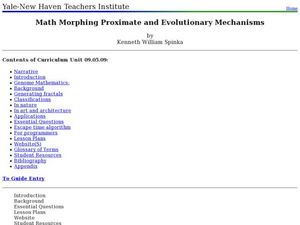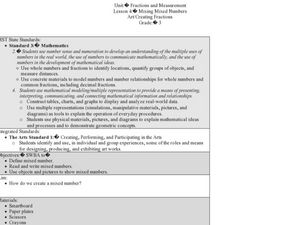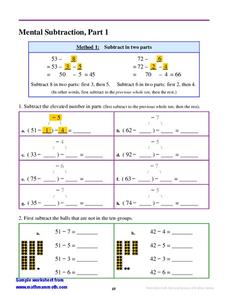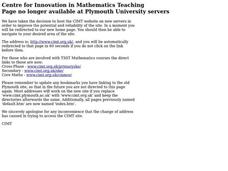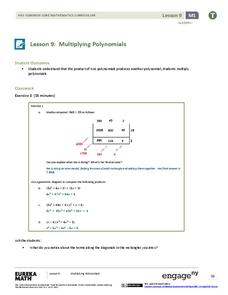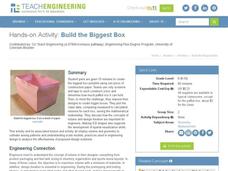Curated OER
Writing up Math in English
Seventh graders review the steps in writing a math problem. They write story problems stating the situation, the problem to be solved, explaining the process used to solve the problem, and state the answer. Students view a PowerPoint...
Curated OER
Math Morphing Proximate and Evolutionary Mechanisms
High schoolers identify the different types of fractals. In this geometry lesson, students use math to analyze different biological phenomena. They collect data from the experiments and construct graphs.
Curated OER
Anzac Maths
In this math worksheet, students read the word problems and apply the information into obtaining the solutions using the correct operation of addition, subtraction, multiplication, or division.
Curated OER
Understanding Fractions
Students explore the parts of an orange to develop an understanding of the addition and subtraction of fractions. The concept of representing parts of a whole by dividing an object into smaller pieces is experienced in this hands-on...
Curated OER
Mixing Mixed Numbers Art/Creating Fractions
Third graders explore number values by participating in class math activities. In this fractions lesson, 3rd graders collaborate with classmates to discuss the technique of adding mix numbers while utilizing paper plates to help...
Curated OER
Sets and Venn Diagrams
In this online sets and Venn Diagrams worksheet, students complete five Venn Diagrams involving whole numbers and twenty five questions. Students check their answers as they go.
Curated OER
Betweenness and the Sum of Parts
High schoolers differentiate lines and angles using betweenness in this geometry lesson. They differentiate angles and lines using Cabri Jr. and analyze the data and make conjecture.
Curated OER
Amazing Transpiration
Learners observe a leaf and discuss the way that water is released from a leaf through its stomata. For this water cycle lesson, students calculate how much water leaves produce from a whole tree.
Curated OER
Mental Subtraction Methods
In this math worksheet, students learn a strategy to mentally subtract a single digit number from a two digit number such as 53-8. Students follow the detailed instructions to subtract in 18 problems.
Curated OER
The Part-adder 1
Second graders investigate the addition of whole numbers. They mentally perform calculations involving addition and subtraction. They make sensible estimates and check the reasonableness of answers.
Curated OER
Percents and Fractions
In this percents and fraction worksheet, students read short story problems, write an equation, and determine the percent or fractional part of a given number. They use the work backwards strategy to determine the initial number. This...
Curated OER
Identifying Fractional Parts of a Whole Unit
In this fractional parts of a whole worksheet, 5th graders examine different arrays that represent a unit. They tell what part of the whole each of given pictures represents, they measure and color fractional parts of a line, and tell...
Curated OER
Fractional Parts of a Whole
In this fractions activity, students solve 4 multi-step problems in which fractional parts of a whole are shaded. Students then show fractions on a number line and solve a problem with fractions and money. This was intended as online...
Curated OER
Unit Fractions
In this unit fractions worksheet, students solve the six word problems using the parts and wholes for each problem to help find the fraction number.
Curated OER
Fractions of a whole
For this fractions worksheet, students count the part of the whole fraction that is colored. Students count 2 problems where they count colored crescent moons.
Curated OER
Fractions, Decimals, and Percentages Got You Down? "Tri" This!
Students explore number sense by creating a math presentation in class. For this parts of a whole lesson, students define and discuss the relationship between fractions, decimals and percentages before completing a problem worksheet in...
EngageNY
Solving Area Problems Using Scale Drawings
Calculate the areas of scale drawings until a more efficient method emerges. Pupils find the relationship between the scale factor of a scale drawing and the scale of the areas. They determine the scale of the areas is the square of the...
EngageNY
Ordering Integers and Other Rational Numbers
Scholars learn to order rational numbers in the seventh lesson in a series of 21. Reasoning about numbers on a number line allows for this ordering.
Illustrative Mathematics
Pick Two
Learning to break apart numbers into smaller pairs is a critical step young mathematicians take as they develop their number sense. To practice this skill, children are provided with sets of three numbers and are asked to pick the two...
Willow Tree
Multiplying Polynomials
Make two parts into a whole. Scholars learn to multiply polynomials to create a simplified polynomial expression. Polynomials include monomial, binomials, and trinomials.
Teach Engineering
Build the Biggest Box
Boxing takes on a whole new meaning! The second installment of the three-part series has groups create lidless boxes from construction paper that can hold the most rice. After testing out their constructions, they build a new box....
National Park Service
Biodiversity—Bee Week
If you want scholars to fall in love with bees, this is the unit for you! Celebrate bees with a full week of material—designed for the Next Generation Science Standards—that addresses the importance of pollination and fertilization....
Illustrative Mathematics
The Stamp Collection
By using language like "half of the stamps," children are exposed to patterns in arithmetic that requires solving a two-step word problem. This type of language opens a new door for transitioning learners toward understanding fractions...
Illustrative Mathematics
Dana's House
Your class is to find the percent of the lot that is not covered by a house. Make sure your pupils understand the problems before they begin. The lot is the whole of the percent problem and the house is the part. The exercise is good...

